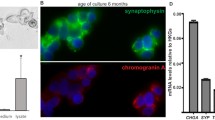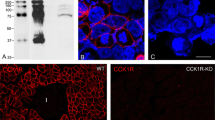Summary
Radioimmunoassays and immunocytochemical techniques were used to assess the effect of cyclocytidine, an antitumor agent, on the level and localization of Epidermal Growth Factor (EGF) in the submandibular gland of the male mouse. A single intraperitoneal injection of 150 mg/kg of cyclocytidine caused, within 6 h, a degranulation of the granular convoluted tubule (GCT) cells and reduced the concentration of immunoreactive EGF in gland extracts by more than 90 %. This effect was largely abolished by the administration of dibenzyline but not by propranolol, indicating that the secretory effect of the drug on the GCT cells is mediated by α-adrenergic receptors. By immunocytochemical staining EGF was localized to the GCT cells. Immunocytochemical staining revealed the same trends in changes in EGF concentration as the radioimmunoassays. However, even at the peak of the cyclocytidine effect there were cells which retained their secretory granules and apparently their EGF complement. In addition, there was a lobular variation in the secretory response. Cyclocytidine caused a transient increase in the blood level of EGF. Furthermore, it stimulated amylase secretion from the gland, which also involved α-adrenergic receptors. Cyclocytidine will be useful in future analyses of the release of various biologically active substances from the GCT cells of the mouse submandibular gland.
Similar content being viewed by others
References
Barthe, P.L., Bullock, L.P., Mowszowicz, L, Bardin, C.E., Orth, D.N.: Submaxillary gland epidermal growth factor: A sensitive index of biologic androgen activity. Endocrinology 95, 1019–1025, (1974)
Bernfeld, P.: Amylases, alpha and beta. In: Methods in enzymology (S.P. Colowick and N.O. Kaplan, eds.). New York: Academic Press 1955
Byyny, R.L., Orth, D.N., Cohen, S., Doyne, E.S.: Epidermal growth factor: Effects of androgens and adrenergic agents. Endocrinology 95, 776–782 (1974)
Chrétien, M., Zajdela, F.: Mise en évidence histochimique de la sécrétion de l'amylase, dans les glandes salivaires sous-maxillaires, retrolingual et sous-parotidiennes de la souris. C.R. Acad. Sci. (Paris) 260, 4263–4266 (1965)
Cohen, S.: Isolation of a mouse submaxillary gland protein accelerating incisor eruption and eyelid opening in the new-born animal. J. biol. Chem. 237, 1555–1562 (1962)
Cohen, S., Savage, C.R., Jr.: Part II. Recent studies on the chemistry and biology of epidermal growth factor. Recent Progr. Hormone Res. 30, 551–572 (1974)
Covelli, I., Rossi, R., Mozzi, R., Frati, L.: Synthesis of bioactive 131I-labeled epidermal growth factor and its distribution in rat tissues. Europ. J. Biochem. 27, 225–230 (1972)
Feldman, H., Rodbard, D.: Mathematical theory of radioimmunoassay. In: Principles of competetive protein-binding assays (W.O. Odell and W.H. Daughaday, eds.). Philadelphia: J.B. Lippincott Co. 1971
Gresik, E., Barka, T.: Immunocytochemical localization of epidermal growth factor in mouse submandibular gland. J. Histochem. Cytochem. 25, 1027–1035 (1977)
Liss, R.H., Charest, M.C., Mead, J.A.R.: Comparative ultrastructure of submaxillary salivary glands from mice treated with cytosine arabinoside, cyclocytidine, and anhydro-ara-5-fluorocytidine, Cancer treatment reports 60, 881–888 (1976)
Liss, R.H., Neil, G.L.: Comparative studies of cyclocytidine (NSC-145668) and cytosine arabinoside (NCS-63878) in mice. Cancer Chemother. Rep. 59, 501–513 (1975)
Lowry, O.H., Rosebrough, N.J., Farr, A.L., Randall, R.J.: Protein measurement with the Folin phenol reagent. J. biol. Chem. 193, 265–275 (1951)
Roberts, M.L.: The in vitro secretion of epidermal growth factor by mouse submandibular salivary gland. Naunyn-Schmiedeberg's Arch. Pharmacol. 296, 301–302 (1977)
Roberts, M.L., Reader, P.C.: The relationship between the secretion of amylase and epidermal growth factor in the mouse submandibular salivary gland. Archs. oral Biol. 30, 693–694 (1975)
Savage, C.R., Jr., Cohen, S.: Epidermal growth factor and a new derivative. Rapid isolation procedures and biological and chemical characterization. J. biol. Chem. 247, 7609–7611 (1972)
Schneyer, C.A., Galbraith, W.M.: Inhibition of cyclocytidine-induced enlargment of parotid and heart by propranolol or sympathectomy. Proc. Soc. exp. Biol. (N.Y.) 150-394–400 (1975)
Schneyer, C.A., Galbraith, W.M., Mellett, L.B.: Unexpected adrenergic effects of the antitumor agent, cyclocytidine on rat salivary glands. Proc. Soc. exp. Biol. (N.Y.) 148, 1206–1211 (1975)
Sternberger, L.A.: Immunocytochemistry. Englewood Cliffs, N.J.: Prentice-Hall, Inc. 1974
Taylor, J.M., Cohen, S., Mitchell, W.M.: Epidermal growth factor: High and low molecular weight forms. Proc. nat. Acad. Sci. (Wash.) 67, 164–171 (1970)
Taylor, J.M., Mitchell, W.M., Cohen, S.: Characterization of the binding protein for epidermal growth factor. J. biol. Chem. 249, 2188–2194 (1974)
Turkington, R.W., Males, J.L., Cohen, S.: Synthesis and storage of epithelial-epidermal growth factor in submaxillary gland. Cancer Res. 31, 252–256 (1971)
Author information
Authors and Affiliations
Additional information
We thank Mrs. T. Ross for her assistance in the morphologic studies. The cyclocytidine was obtained through the courtesy of Dr. H.B. Wood, Jr., Drug Development Branch of the Division of Cancer Treatment, NCI, NIH and Dr. J. Holland, Mount Sinai School of Medicine
This investigation was supported by United States Public Health Service Research Grants CA 17038 and CA 11155 from The National Cancer Institute
Rights and permissions
About this article
Cite this article
Barka, T., Gresik, E.W. & van der Noen, H. Stimulation of secretion of epidermal growth factor and amylase by cyclocytidine. Cell Tissue Res. 186, 269–278 (1978). https://doi.org/10.1007/BF00225536
Accepted:
Issue Date:
DOI: https://doi.org/10.1007/BF00225536




